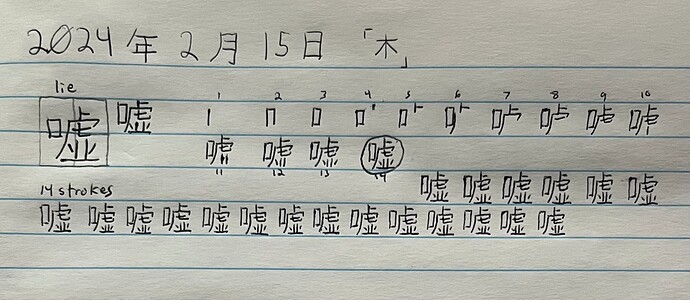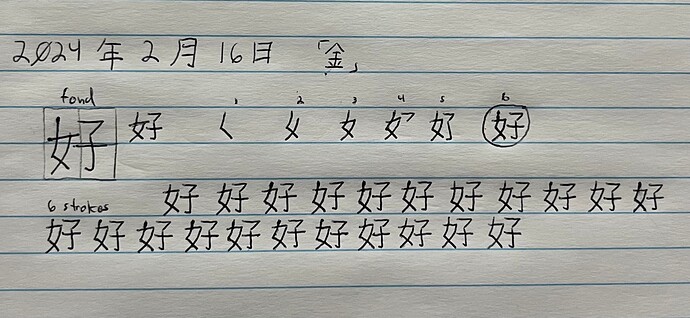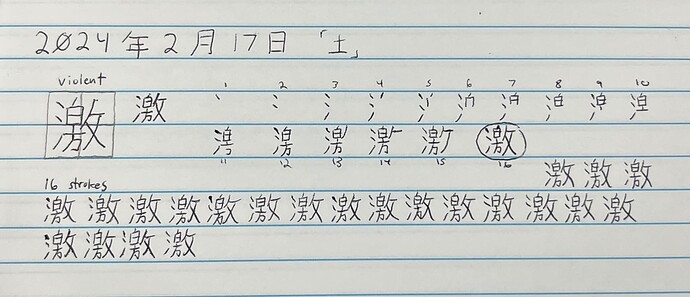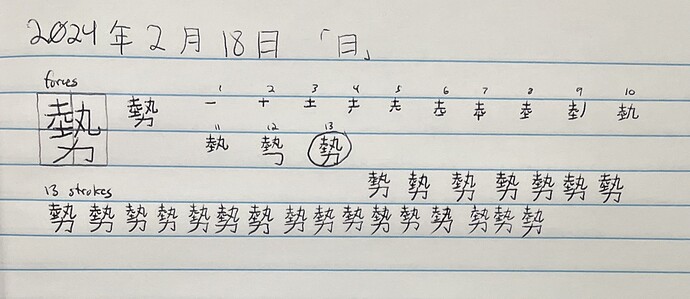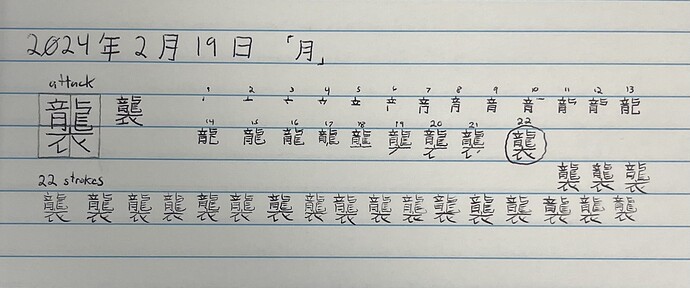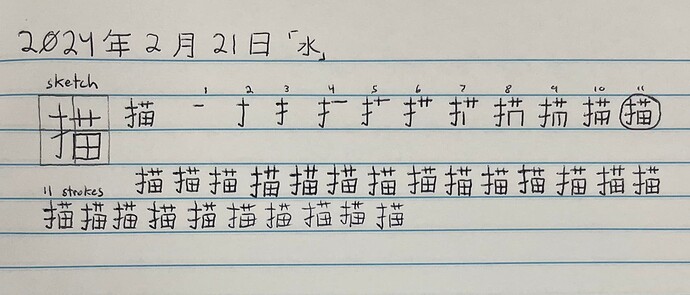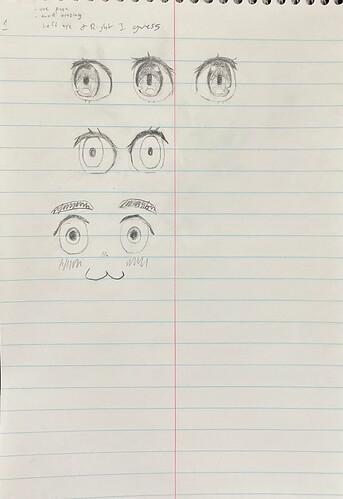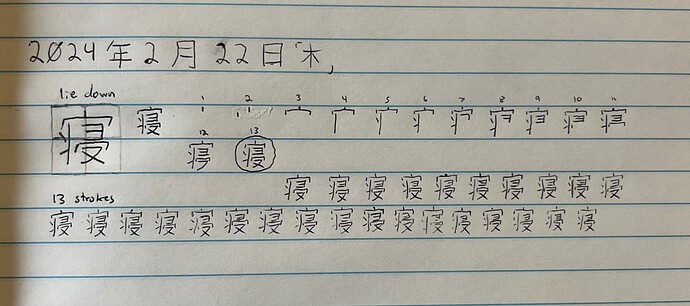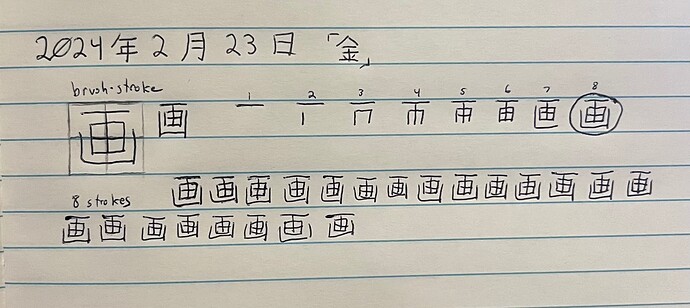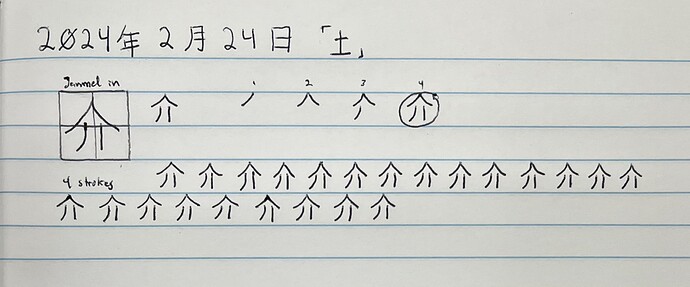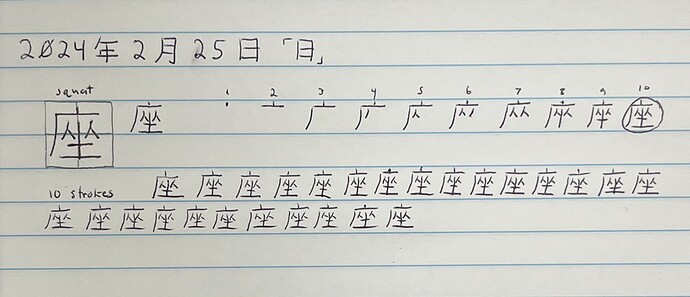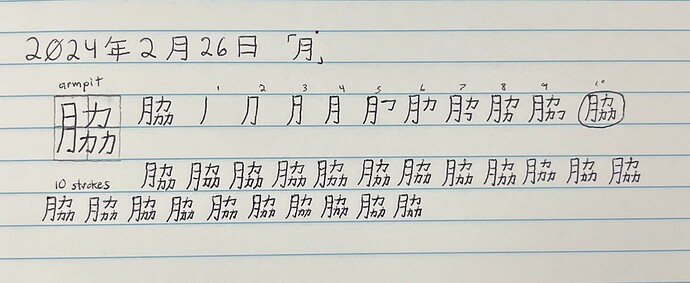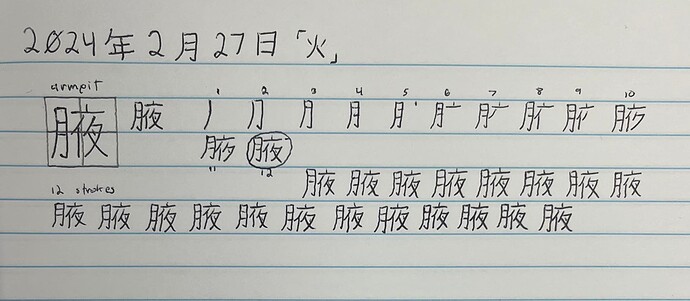この場所で、恋が居なかった…
ぴえん
2024年2月15日「木」
漢字:嘘
訓読み:うそ、ふ.く
音読み:キョ、コ
Jisho Page
2024年2月16日「金」
漢字:好
訓読み:この.む、す.く、よ.い、い.い
音読み:コウ
Jisho Page
メモ:Double feature, as I royally messed up my sleep schedule these last couple days.
While not impossible, balancing the parts of the character 「嘘」was quite difficult at first. I feel like I did a good job, but it was a good challenge.
On the other hand, 「好」gave me more practice on the 「女」radical, which is always a good thing!
Hi! Nice as always.
Yesterday I was reading something and this kanji showed up ‘墟’. It was a lie that reminded me of it! 
Though sharing the ‘tiger’ radical with ‘the lie’, there is a little catcus-like feature at the bottom that caught my eye. HYLI!
とにかく、良い週末を
2024年2月17日「土」
漢字:激
訓読み:はげ.しい
音読み:ゲキ
Jisho Page
メモ:This popped up in my Anki deck and I was having trouble with it, so I decided to write it out.
I feel like it wasn’t all that bad in comparison to other characters I’ve done, but it was difficult to get the balance just right.
I’ll have a look at it here soon, Thank you for the suggestion!
2024年2月18日「日」
漢字:勢
訓読み:いきお.い、はずみ
音読み:セイ、ゼイ
Jisho Page
メモ:Another problem child from my Anki Deck.
Wasn’t sure what kanji to go with today so this is what I ended up with. At 13 strokes, it’s very hard to balance, with the modified 先 radical above the modified 土 radical both on the left side over the 力 radical on the bottom.
2024年2月19日「月」
漢字:襲
訓読み:おそ.う、かさ.ね
音読み:シュウ
Jisho Page
メモ:For the life of me I could not remember the Kun’yomi reading for this character during my reviews, so I decided to write it out for more practice.
While the radicals are all different, today’s character shares a lot of difficulty with yesterday’s Kanji 「勢」in having to balance the individual parts. After doing the stroke order as properly as I could, my hand was already starting to hurt, so I tried to loosen my grip on my pen and write the practice characters out a bit quicker and sloppier, but I think they still look pretty legible.
Hi!
How about this mnemonic?: “Oh, so this is the dragon (龍) that wears blue sued SHOES and attacks just dressed (衣) with an umbrella (傘), ね!?”
HTH!
I have to say, that’s quite the mnemonic you have there…
I’ll give it a shot, thank you for the input!
2024年2月20日「火」
漢字:抱
訓読み:だ.く、いだ.く、かか.える
音読み:ホウ
Jisho Page
メモ:For some reason I just couldn’t get this one down. I kept wanting to write the 口 radical in this Kanji even though it’s not present anywhere. Anyways, I wrote this because I want a hug.
2024年2月21日「水」
漢字:描
訓読み:えが.く、か.く
音読み:ビョウ
Jisho Page
メモ:Very similar to 猫、I seem to have a hard time balancing this one in a way that looks good. It’s definitely readable, but it’s not very aesthetically pleasing.
I chose this character today because I tried my hand at drawing today!
Drawing Practice
I’ve never been super good at art. When I have a reference, I can usually mimic it quite well, but I want to be able to actually draw things free-hand, and make original drawings of my own someday, so why not start now?
The first line is a number of attempts I drew using a reference photo, and the second and third line were entirely freehand.
Obviously shading makes a huge difference, but I’m planning on working on more eye shapes and angles in the future! If I feel inspired, I may sneak them in these posts moving forward.
2024年2月22日「木」
漢字:寝
訓読み:ね.る、い.ぬ、みたまや、や.める
音読み:シン
Jisho Page
メモ:Something I’ve been doing too much of lately…
I remember when I first started learning Japanese, for some reason I always thought of this Kanji as being the most difficult thing ever. After being introduced to Kanji like 襲、繭、警 and others still, I have reevaluated my opinion.
Part of my practice today was also fixing my posture while writing. I find that in order to perfect my Kanji, i will hunch over waaay too much. This is really awkward and not good for my back, so for today’s writing practice I consciously made an effort to pull back and write properly.
嘘 also has a variation that has the cactus: 噓. The LN series I’ve been reading uses it, but I didn’t even notice until I was halfway through the fifth and final volume lmao. It probably did get furigana for each of its first appearances, but I didn’t pay any special attention to it until I just randomly noticed that one of the radicals was different
2024年2月23日「金」
漢字:画
訓読み:えが.く、かく.する、かぎ.る、はかりごと、はか.る
音読み:ガ、カク、エ、カイ
Jisho Page
メモ:Very important to writing out Kanji!
Simple and quick to write out. Still trying to work on my sitting posture while also making sure my Kanji come out right.
No longer focusing on perfection, but rather readability and ease of writing.
Planning on going back to body-themed Kanji next week!
2024年2月24日「土」
漢字:介
訓読み:N/A
音読み:カイ
Jisho Page
メモ:Sort of chose this one at random.
Taken from 「介添え」、Today’s Kanji is a relatively simple one.
Drawing Practice
On to day 4 of my drawing journey.
Not super happy with how they’re turning out, but I still need a lot more practice when it comes to drawing eyes.
In comparison, in anime/manga style, noses and mouths are incredibly simple, so once I get eyes down better and get my spacing fixed, I should be able to start constructing faces.
Also, bonus points if anyone can figure out what characters I’m drawing!
2024年2月25日「日」
漢字:座
訓読み:すわ.る
音読み:ザ
Jisho Page
メモ:Since I was talking about it so much over in the Shiritori Thread, Today’s Kanji is all about sitting!
This is a nice one to end on, and then I’ll be getting back into Body-Themed Kanji starting tomorrow.
2024年2月26日「月」
漢字:脇
訓読み:わき、わけ
音読み:キョウ
Jisho Page
メモ:Moving back from the arms into the torso, we may be here for a while.
Surprisingly, there are at least 3 separate Kanji that hold the meaning of “Armpit”. I’m going to limit it to 2, because that’s what I did with “Cheeks”, being 「頬」and「頰」、otherwise I don’t think I’d end up getting very far. Stay tuned!
Wow! So much “power”!
2024年2月27日「火」
漢字:腋
訓読み:わき
音読み:エキ、セキ
Jisho Page
メモ:Here’s number two!
Only a couple more strokes than yesterday’s kanji, this one seems to be used more in anatomical settings? As well as for words like 「腋毛」 “Armpit Hair”. If anyone knows the difference between the two, I’d love to hear it!
Yeah, right? There seems to be a number of Kanji with this radical pattern, with only the leading radical changing, like 協 and 恊、and there are a few more with the triple-radical pattern with stuff like 姦 and 皛.


